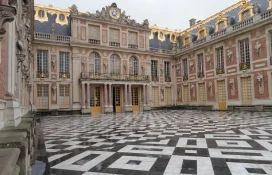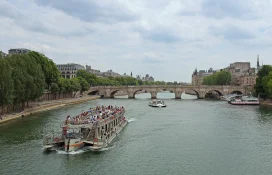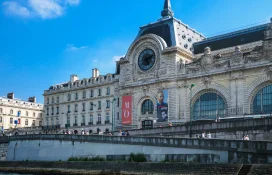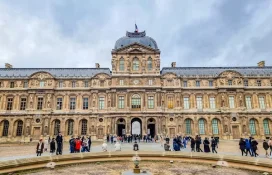Arc de Triomphe History

Support when you need it
Customer service to help you with all your needs from 8:00 a.m. to 7:00 p.m.
Fast and online booking
Choose the best option for your needs and preferences and avoid the lines.
Top attraction in Paris
Discover history and stunning views at the Arc de Triomphe.
Arc de Triomphe History Timeline
The Arc de Triomphe’s history is a sweeping narrative spanning over 200 years, reflecting France’s turbulent political and cultural evolution. Commissioned by Napoleon Bonaparte in 1806 after his decisive victory at the Battle of Austerlitz, the monument’s construction began as a tribute to his Grande Armée. However, progress stalled during Napoleon’s exile in 1814 and the Bourbon Restoration. Work resumed in 1825 under King Louis XVIII and was finally completed in 1836 under King Louis-Philippe.
Beginnings of the Arc de Triomphe
The origins of the Arc de Triomphe trace back to Napoleon Bonaparte’s ambition to rival the grandeur of ancient Rome. After his triumph at Austerlitz in 1805, he declared, “You will return home through arches of triumph,” and tasked architect Jean Chalgrin with designing a monument to immortalize his military glory. Inspired by Rome’s Arch of Titus, Chalgrin envisioned a neoclassical structure scaled to dwarf its predecessors. The site chosen—Place de l’Étoile (now Place Charles de Gaulle)—was a strategic crossroads at the western end of the Champs-Élysées, symbolizing Paris as the heart of Napoleon’s empire.
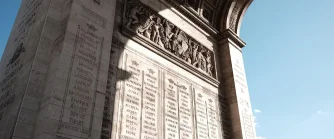
Why Was the Arc de Triomphe Built?
Napoleon conceived the Arc de Triomphe as both a propaganda tool and a homage to his soldiers. Its primary purpose was to glorify his military conquests and unify France under his rule, drawing parallels to Roman emperors who used triumphal arches to legitimize their power. However, after Napoleon’s fall, subsequent regimes repurposed the arch to serve broader national ideals. King Louis-Philippe, who oversaw its completion in 1836, dedicated it to the “Armies of the Revolution and the Empire,” subtly shifting its focus from Napoleon’s ego to collective French valor.
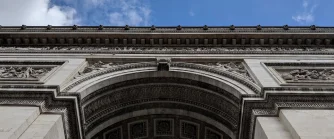
Arc de Triomphe Construction
The construction of the Arc de Triomphe was a marathon beset by political and logistical challenges. Jean Chalgrin’s original design called for a massive 50-meter-high arch adorned with allegorical reliefs and inscriptions. Work began in 1806 but stalled in 1814 due to funding shortages and Napoleon’s downfall. Chalgrin’s death in 1811 further complicated progress, leading to design revisions by architects Louis-Robert Goust and Jean-Nicolas Huyot. The Bourbon Restoration (1815–1830) initially neglected the project, but Louis-Philippe, seeking to bridge political divides, restarted construction in 1833.

Arc de Triomphe Significance
The Arc de Triomphe is far more than an architectural marvel—it is a sacred site of French memory. Its most profound symbolism lies in the Tomb of the Unknown Soldier, interred in 1920 to represent the 1.4 million French lives lost in WWI. The eternal flame, rekindled daily since 1923, serves as a poignant reminder of sacrifice. Sculptures like The Departure of the Volunteers (La Marseillaise) and The Triumph of 1810 fuse art with ideology, depicting France as both a defender of liberty and a military powerhouse. Geographically, it anchors the Axe Historique, a straight line connecting the Louvre, Place de la Concorde, and La Défense, framing Paris as a city of order and ambition.
Arc de Triomphe Today
Today, the Arc de Triomphe is a UNESCO World Heritage Site and one of Paris’s most visited landmarks, drawing over 1.5 million annual visitors. The rooftop terrace offers panoramic views of the Champs-Élysées, Montmartre, and the Eiffel Tower, while the underground museum details its history through interactive displays. Recent restorations (2018–2021) addressed centuries of wear, including cleaning sculptures blackened by pollution and reinforcing structural integrity.
Get your tickets now to learn the complete Arc de Triomphe History
To fully immerse yourself in the arch’s history, secure tickets for its terrace and museum. Climb the 284 steps (or take the elevator) to the rooftop for breathtaking views, then explore exhibits detailing Napoleon’s vision, the Unknown Soldier’s legacy, and 20th-century restorations.
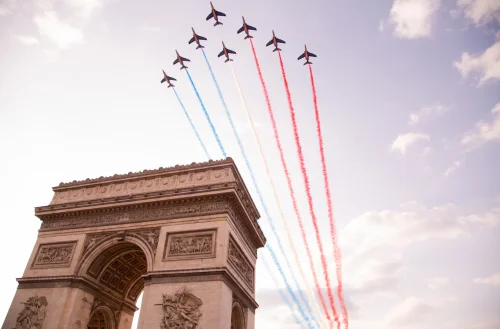
FAQs About the Arc de Triomphe History
The arch symbolizes France’s military triumphs, revolutionary ideals, and collective memory. It honors soldiers from the Revolution through WWII, serving as a site for national mourning (via the Unknown Soldier) and celebration (e.g., Bastille Day). Its sculptures and inscriptions reflect France’s identity as a defender of liberty, while its location reinforces Paris’s urban symmetry.
Construction began in 1806 under Napoleon but faced delays due to political instability. Active work occurred in two phases: 1806–1814 (Napoleonic era) and 1825–1836 (Bourbon monarchy). The arch was officially inaugurated on July 29, 1836.
Napoleon commissioned it to celebrate his 1805 victory at Austerlitz and glorify his Grande Armée. Though initially a personal monument, later regimes repurposed it to honor all French military achievements, transcending its imperial origins.
Architect Jean Chalgrin designed the arch, drawing inspiration from Roman models. After his death in 1811, Jean-Nicolas Huyot and Guillaume-Abel Blouet modified the design. Sculptors François Rude, Antoine Étex, and Jean-Pierre Cortot created its iconic reliefs.
From foundation (1806) to completion (1836), the project spanned 30 years, though active construction totaled roughly 15 years due to interruptions during Napoleon’s exile and the Bourbon Restoration.
Key events include Napoleon’s 1840 funeral procession, the 1920 interment of the Unknown Soldier, the 1940 Nazi occupation, the 1944 Liberation of Paris, and modern interventions like Christo’s 2021 installation. Each event redefined its cultural and political role.
It functions as a memorial, tourist site, and ceremonial space. The Centre des Monuments Nationaux oversees conservation, including stone cleaning, structural repairs, and climate control systems. Public access is balanced with preservation, ensuring its survival as a UNESCO landmark.
Other things to do in Paris

